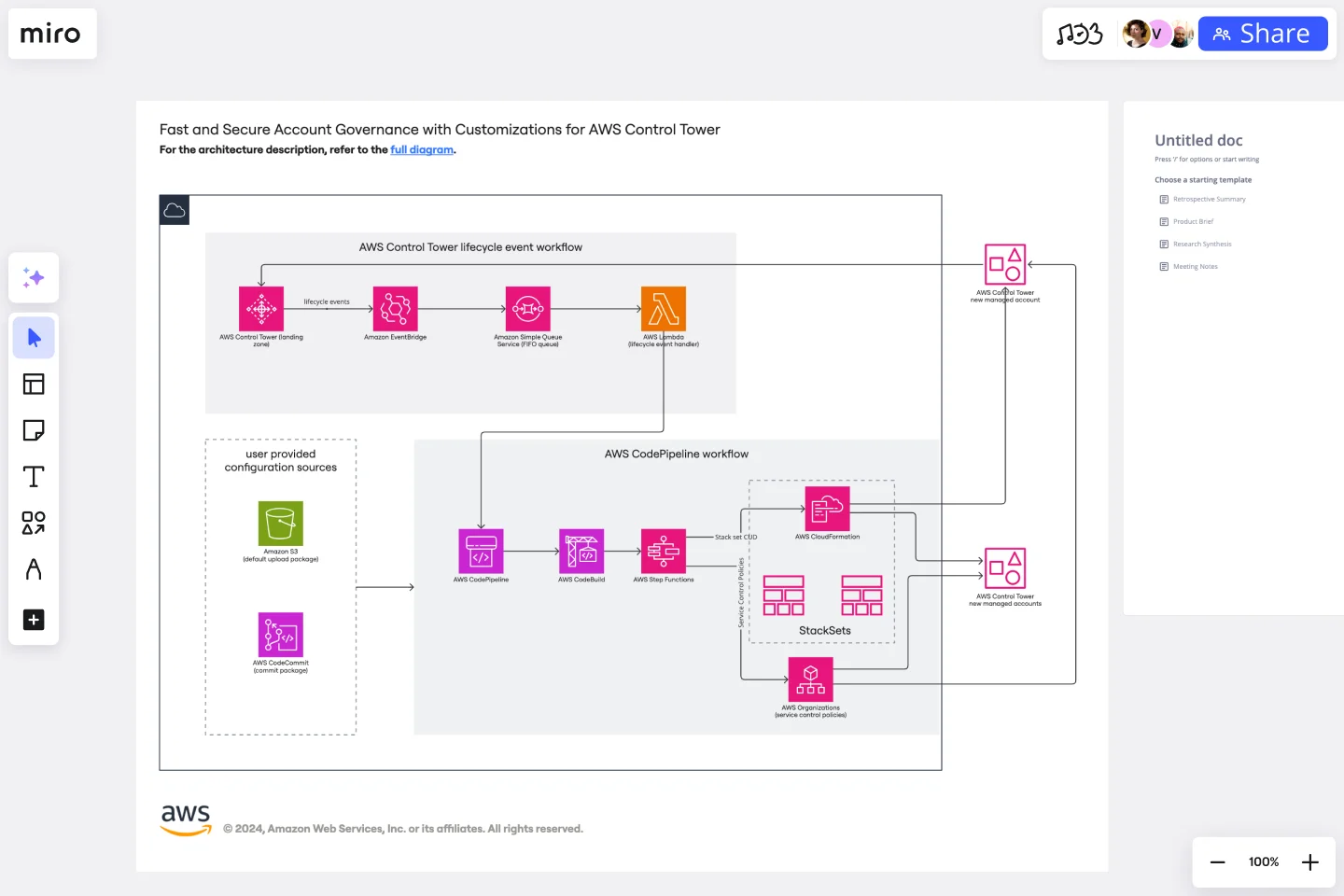AWS Control Tower Account Governance Template
Streamline the setup and management of governance across multiple AWS accounts with the AWS Control Tower Account Governance Template.
Available on Enterprise, Business, Education plans.
About the AWS Control Tower Account Governance Template
The AWS Control Tower Account Governance Template is a powerful tool designed to streamline the governance of AWS accounts, ensuring that your AWS environment is set up and managed according to best practices for security, operations, and compliance. This template is particularly useful for organizations looking to automate and enforce governance rules across multiple AWS accounts efficiently.
How to use the AWS Control Tower Account Governance Template
Customize the template: Depending on your organization's specific needs and policies, you may need to customize the template. This could involve adding, removing, or modifying certain sections to better align with your governance requirements. Miro's flexible editing tools make it easy to tailor the template to your needs.
Collaborate with your team: Miro's collaborative features allow you to work on the template with team members in real time. You can discuss changes, assign tasks, and gather feedback directly within the Miro board. This collaborative approach ensures that everyone is aligned and contributes to the governance process.
Implement governance controls: After customizing the template to your organization's needs, you can begin implementing the governance controls outlined in the template. This may involve setting up AWS Control Tower, configuring guardrails, and establishing account structures as recommended in the template.
Review and iterate: Governance is an ongoing process. Regularly review the effectiveness of your governance controls and make adjustments to the template as needed. Miro's version history feature allows you to track changes over time and revert to previous versions if necessary.
Why use the AWS Control Tower Account Governance Template
Efficiency: Automates and simplifies the process of setting up and managing governance across multiple AWS accounts.
Best practices: Ensures that your AWS environment is aligned with AWS best practices for security, operations, and compliance.
Collaboration: Facilitates collaboration among team members, allowing for a unified approach to governance.
Customization: Offers the flexibility to tailor governance controls and policies to fit the unique requirements of your organization, ensuring that the AWS environment aligns with your specific security, compliance, and operational standards.
Visibility and control: Provides a centralized view of your AWS environment, making it easier to monitor compliance with governance policies and identify issues before they become problems.
Scalability: As your organization grows, the template scales with you, facilitating the management of an increasing number of AWS accounts without compromising on governance standards.
Security: Enhances the security posture of your AWS environment by implementing best practices and guardrails that protect your resources and data.
Compliance: Helps ensure that your AWS environment complies with internal policies and external regulations, reducing the risk of non-compliance penalties.
Cost management: By enforcing governance policies, you can avoid unnecessary costs associated with over-provisioned resources and inefficient configurations.
Get started with this template right now. Available on Enterprise, Business, Education plans.
Dichotomous Key Template
Works best for:
Diagramming
The Dichotomous Key Template stands out as an exceptional tool for simplifying complex classification processes, significantly enhancing learning experiences. Breaking down intricate subjects into a series of binary decisions transforms how information is absorbed and understood. This systematic approach not only aids in retaining intricate details but also makes the learning process more engaging and interactive. Whether for educational purposes or professional use, the template’s design fosters a deeper comprehension of the subject matter, allowing learners and professionals to navigate complex scenarios with clarity and ease.
UML Class Content Management System (CMS) Template
Works best for:
UML
The UML Class Content Management System CMS Template simplifies documenting and designing the architecture of a Content Management System. It allows for the creation of UML class diagrams to visualize the structure of a CMS. Teams can efficiently map out key classes and their interactions, such as how users create, manage, and publish digital content. The template's integration into Miro's collaborative platform allows for real-time teamwork, customization, and easy sharing of feedback. This streamlines the documentation process and is valuable for software development projects aiming to develop or refine a CMS.
Venn Diagrams by Dave Westgarth
Works best for:
Venn Diagram
Visualize relationships and intersections clearly with the Collection Venn Diagram template. This tool is perfect for comparing multiple sets of data, identifying commonalities, and showcasing unique elements. Use it in presentations, research, and data analysis to make complex information more digestible. Ideal for educators, researchers, and analysts seeking to present data insights effectively.
UML Component Diagram Template
Works best for:
Mapping, Diagrams, Software Development
Use our Component Diagram template to show how a system’s physical components are organized and wired together. Visualize implementation details, make sure planned development matches system needs, and more — all in a collaborative environment.
ERD Educational Learning Management System Template
Works best for:
ERD
The ERD Educational Learning Management System Template is designed to streamline the management and organization of educational systems, particularly useful for institutions adapting to online and hybrid learning environments. It helps in efficiently planning and implementing Learning Management System (LMS) features by identifying key entities such as Students, Courses, Instructors, Assignments, and Grades, and the relationships between them.
Value Network Mapping (1.0)
The Value Network Mapping (1.0) template is a visual tool for analyzing and optimizing the relationships and interactions between stakeholders within a network. It provides a structured framework for mapping out value exchanges, dependencies, and opportunities for collaboration. This template enables teams to gain insights into the dynamics of their ecosystem, identify key actors, and align strategies for mutual benefit. By promoting transparency and collaboration, Value Network Mapping empowers organizations to enhance value creation and foster strategic partnerships.
